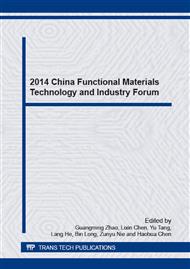p.500
p.503
p.507
p.514
p.520
p.527
p.535
p.540
p.546
Synthesis and Characterization of Biomedical Aliphatic Polyurethane Material
Abstract:
Biomedical transparent poly(carbonate-urethane) elastomers were synthesized by melting pre-polymer method, using 4,4’-methylenebis (cyclohexyl isocyanate)(H12MDI) and chain extender (butadiene)(BDO) as hard segment, poly(1,6-hexanediol) carbonate diols(PCDL) as soft segment, and dibutyltin dilaurate as catalyst.The effects of molar ratio of the reactants on mechanical properties of PCU were studied and the relationship between micro-phase separation structure and properties was analyzed by the contact angle determination, total reflection fourier transform infrared spectrography(ATR-FTIR), differential scanning calorimeter(DSC),gel permeation chromatograph (GPC), mechanical property test. The comparative analysis was made between the prepared material and commercial medical polyurethane materials, showing the prepared poly(carbonate-urethane) elastomers was better in mechanical properties. As a elastic biomedical material, it has a great potential for developments and applications in biomedical materials.
Info:
Periodical:
Pages:
520-526
Citation:
Online since:
December 2014
Authors:
Price:
Сopyright:
© 2015 Trans Tech Publications Ltd. All Rights Reserved
Share:
Citation:


